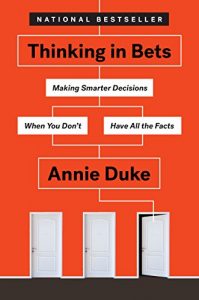Investing And Life Are More Like Poker Than Chess
“Success is nothing more than a few simple disciplines, practiced every day.” – Jim Rohn
Investing and life are more like poker than chess. I recently listened to an interview with Annie Duke. Ms. Duke’s book, Thinking in Bets along with the interview really resonate with me because her thinking is quite similar to mine.
In this quick video, I detail the parallels of investing and poker and why it is critical to keep a “poker face,” keeping your emotional composure during bad….and even good investment periods!

I like this book for many reasons, the greatest one being the statement, “Even the best decision doesn’t yield the best outcome every time.” In poker, like in investing, you can make the best decisions but there are still unknown elements at play.
_________________________________________________________________________
Transcript of the video:
Hi there. Mike Brady with Generosity Wealth Management, a comprehensive, full service financial firm headquartered right here in Boulder, Colorado.
Today I want to talk about how investing and life is more like poker than it is chess. I got a lot of these ideas I’m going to share with you today from an interview and a book that I read by Annie Duke. I’m going to put a link in the newsletter and in the transcript of this. (http://a.co/aw2KM5f) Annie Duke, Thinking in Bets.
And when I heard her interview on this podcast it was like she was speaking right to me because that’s the way I think. And so of course I thought she was brilliant. If you watch my videos going back seven, eight, nine years you’ll hear that I talk in well let’s increase our probability of success. And I think the odds are because that’s really the way life and investing is. Let’s think about chess for a second. Chess there’s these pieces on the board and all of them are visible. You see it and so does your opponent. With all that visibility it’s a completely logical game. The person who is the more experienced, the person who is the better player should always win. And if that person doesn’t win then they can go back piece by piece or play by play and say oh, this is where I made a mistake.
That’s not the case with poker. Let’s talk about poker for a bit. You don’t get to see all the cards so there’s a hidden element there. It’s all a bunch of odds. You might have an 85 percent probability, 90 percent. But there’s still 10 percent that you could be wrong. And it doesn’t mean that you were wrong because the outcome went against you. But there were things that you didn’t know. There were unforeseen things and there is luck. I’m not going to ask you to raise your hand but if I was to say who has run a red light, most of us would raise our hand. Even if it’s only once in our life or if it’s once a day. Just because you run a red light doesn’t mean you automatically get hit although it dramatically increases your odds of getting hit. Just like if you’re following the rules and you go through a green light it doesn’t guarantee that you won’t get hit, T-boned by somebody else. So there are factors outside of our control that we have to understand.
When we’re looking at a poker game, a typical poker hand a professional might take two minutes. Therefore, you might have 30 hands in an hour. And a professional poker player is going to know the odds. They have to work really hard to know the odds, play the game, to be cool. Maybe there’s a string of bad luck that you have but you stick to your particular core knowing that you’re a really good player. You know the odds better than the people that you’re playing against and you just can’t get too emotional one way or the other. If you’ve ever seen a poker game nobody’s jumping up and down when they win or at two, three or four hands they’re getting super depressed. Maybe amateurs are but definitely not the professionals.
So investing is very similar. We can do the best that we can with all the different variables that are known to us we can come up with a strategy. We can say wow, I think the market is going to do this, I think the market is going to do that. And we could be wrong because there are going to be things that are unforeseen that are going to be in the future. Nobody knows the future. So that by definition is going to be a variable that we’re not able to account for fully. Therefore, what do we do? What we do is we, of course, look at a diversified portfolio. We say well how can I not stick my neck out so much that if that 10 percent or that 20 percent or whatever the number is that I’m wrong, I’m really stuck that I’ve lost so much. How much are you willing to risk? So a diversified portfolio is very, very important. Staying in it for the long term. If you find your strategy that works with your risk level, your tolerance, that allows you to stay emotionally cool it’s got to be a long term. If you were a poker player it might be many hours. If you are an investor it should be many years. And so you’ve got to keep that in mind as well.
Life is full of unknown variables so we try to increase our knowledge. We try to increase it so we can make the best decisions. We try to learn from those decisions as well. It is not a chess game. It’s not a guarantee. So if you’re looking for a guarantee then investing in life, you know, you’ve come to the wrong place so you’re never going to get that and you’re going to be continually disappointed.
Mike Brady, Generosity Wealth Management, 303-747-6455. You have a great day. Thanks. Bye bye.
